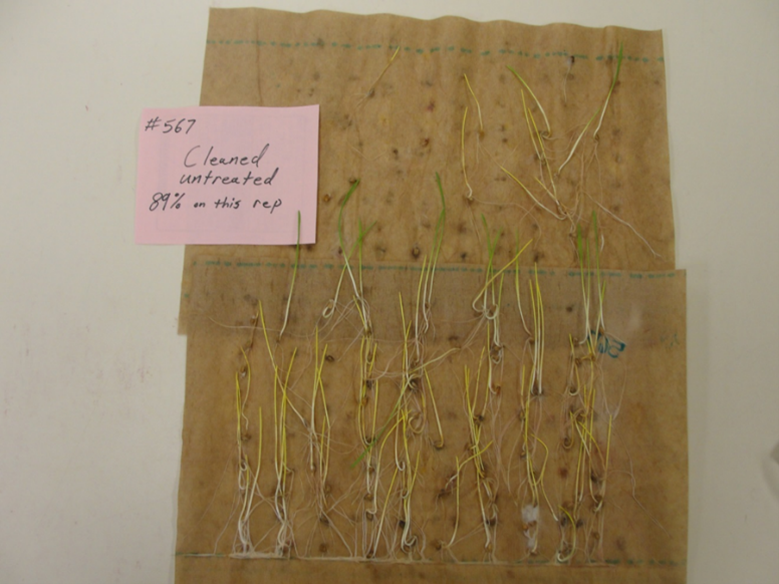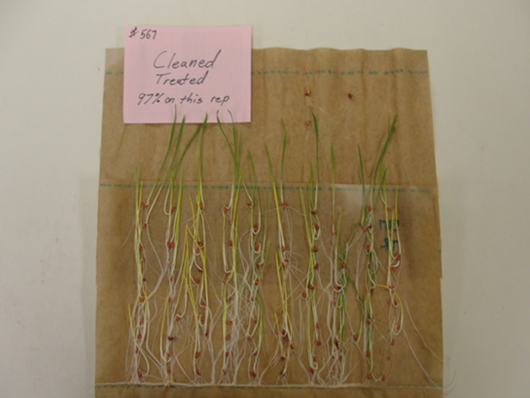7.6 – Use of Seed Conditioning to Manage Seedborne Pathogens – Examples
Examples of Using Seed Conditioning to Manage Seedborne Pathogens
Wheat Scab or Fusarium Head Blight
This disease, caused by Fusarium graminearum, is a fungal infection affecting small grains and corn. It impacts plant heads and, under optimal conditions, seed tissue as well. The severity of infection varies with environmental conditions. In severe cases, infected seeds appear white, chalky, shriveled, or pink, and are often referred to as “stones” or “tombstones.” These tombstone seeds indicate that other seeds in the lot may also be infected, even if to a lesser degree. The fungus can infect the seed embryo, often killing it and thereby preventing germination.
Tombstone seeds are aptly named—they significantly reduce germination percentages. These seeds are included in germination percentage calculations as non-viable seeds.
Click on the “!” signs on this picture of seeds infected with Fusarium Scab to learn more information on the disease and its symptoms.
Seeds that do not germinate or that develop into abnormal seedlings count against the total germination rate. Scab-infested seeds often produce the following abnormalities:
- Thin, spindly, pale, or watery shoots
- Seedlings with impaired essential structures due to decay from primary infection
Removing tombstones during seed conditioning is essential.
For small grains, air screen cleaners and secondary cleaning with gravity tables or indent machines are highly effective. In cases where scab is present, secondary cleaning with gravity tables or indent machines is crucial. If only air screen equipment is used, many scab-infected seeds will remain. Gravity tables are especially effective due to their ability to separate lighter, infected seeds.
Another management strategy is the use of fungicide seed treatments. These treatments, discussed in more detail later in this lesson, can control Fusarium on the surface of infested seeds. If the seed is initially viable (i.e., the fungus has not infected the embryo), fungicide treatments will kill fungal spores on the seed surface. However, fungicides cannot rescue seeds that have already been killed by the fungus.
 |
 |
| Conditioned and Untreated seed; Germination is 89% | Conditioned and Treated seed; germination is 97% |
Image: Conditioned and untreated seed (89% germination) vs. conditioned and treated seed (97% germination) – Photo by Colorado Seed Lab; comparing conditioned treated and untreated wheat seed germination.
Ergot in Small Grains and Forage Grasses
Ergot is a fungus (Claviceps purpurea) that infects developing seeds and eventually replaces the seed with a sclerotia (fungal reproductive body). Ergot infects many cereals and grasses, including: (in order of decreasing susceptibility) rye, triticale, wheat and barley. Oats are rarely affected. Yield reductions are usually slight. However, the ergot bodies contain toxic alkaloids that are poisonous to humans and livestock. For more information on ergot poisoning refer to this video from the University of Nebraska.
There is no fungicide control for ergot. The only effective management is the removal of sclerotia from seed and grain sources through proper cleaning and conditioning with primary and secondary equipment. It is also essential to prevent livestock from grazing on ergot-infested crops.
Click on the “!” signs on this picture of seeds infected with Ergot to learn more information on the disease and its symptoms.
Review
Work through these interactive questions to review the important concepts discussed.

